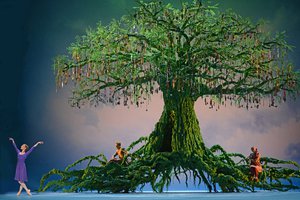Christopher Wheeldon's 'The Winter's Tale'
The Winter's Tale
Ballet performance at the Royal Opera House, Tuesday 7th June 2016
Review by Gemma Miller, PhD Candidate in English

The Winter's Tale, Royal Opera House
Adapting one of Shakespeare’s most notoriously problematic plays into its first full-length ballet was a brave decision by choreographer Christopher Wheeldon. First staged in 2014, the idea arose out of a conversation with Nicholas Hytner, who was then artistic director at the National Theatre. Wheeldon evidently likes a challenge, as Hytner told him The Winter’s Tale was ‘fairly jumbled’ and that Shakespeare had got ‘a little bit lazy’ by the time he came to write it in 1611. However, as his last adaptation of Alice’s Adventures in Wonderland in 2011 demonstrated, Wheeldon is more than capable of turning the wordiest of texts into coherent and compelling visual narratives.
The spatiotemporal disjunctions of Shakespeare’s play were condensed into three distinct acts, taking the audience from the cool, neoclassical elegance of Sicilia forward 16 years to the bohemian ebullience of Bohemia and back again. It opened with a prologue that featured the two kings, Leontes and Polixenes, as young boys, briefly recreating the ‘twinn’d lambs’ idyll of their childhood. They were then swiftly replaced with the adult kings, whose pas de deux was transformed into a pas de trois, as a heavily-pregnant Hermione was passed from one to the other. Leontes’ descent into jealous paranoia was conveyed via convulsive, writhing movements that began with a claw-like hand on Hermione’s belly and gradually became a poisonous spider affecting his whole body.
Heavy percussive sounds dominated the musical score, their tick-tock rhythms striking an ominous note of impending doom. At Hermione’s trial, a pyjama-clad Mamillius, teddy-bear in hand, gradually descended a sweeping staircase, reaching the bottom in time for his death to be announced. The first act ended with a spectacular storm, an animatronic baby in a Moses basket (the moving limbs were disturbingly realistic), and a billowing silk sheet with the image of a bear engulfing Antigonus in its folds.
In contrast to the high melodrama of act one, act two was a vivid burst of colour and effervescence. A jewel-encrusted tree dominated the set, beneath which sat a rustic band who provided a rousing soundtrack to the acrobatic divertissements of the dancers. It was a breathtaking display of pas de deux merging into ensemble choreography, eliciting rapturous bursts of applause. It felt rather anti-climactic, therefore, to follow this exuberant act with a return to the muted tones and angst-ridden, stylized dancing of the final act.
The reconciliation scene, which in Shakespeare’s text provides a truly heart-stopping moment of coup de théâtre, also fell disappointingly flat. The final moments, however, were saved from bathos when a statute of Mamillius was revealed. Leontes reached out a hand to touch him, hoping that he too would be re-animated. As Paulina gently led him away, we were reminded that, in spite of the ‘happy ending’, a young boy had died and miracles are in short supply.

